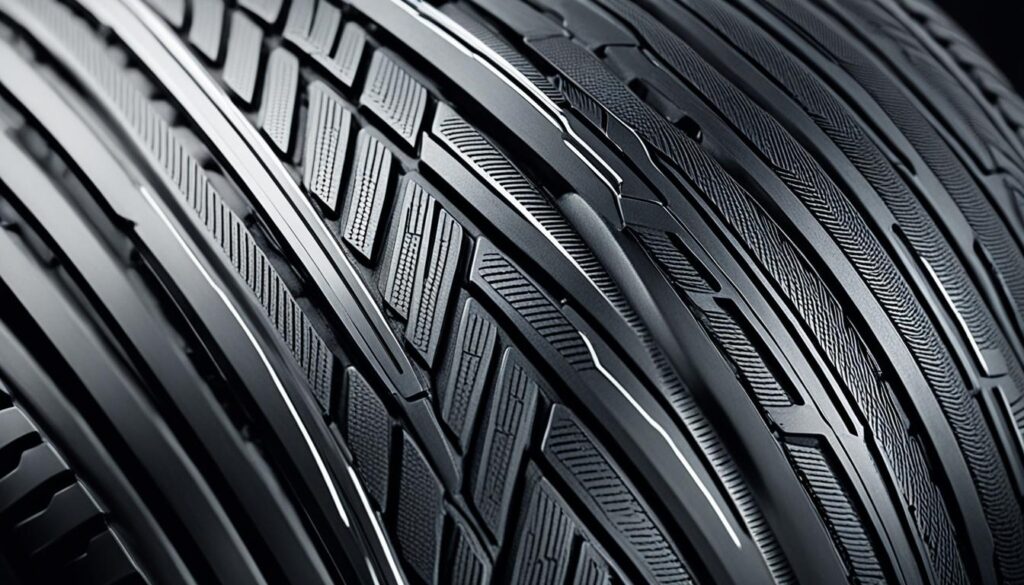As an Amazon Associate, I earn from qualifying purchases
When it comes to choosing the right tires for your vehicle, there are a lot of options to consider. Among them, two popular choices are low profile tires and regular tires. But what exactly are the differences between these two types of tires, and which one is the right choice for you?
Low profile tires have been gaining popularity among regular vehicle owners due to their numerous advantages. These tires offer improved handling, better fuel efficiency, enhanced braking performance, and a sleek and sporty look. On the other hand, regular tires provide a smoother ride, better stability, and greater grip on irregular surfaces and in inclement weather conditions.
Key Takeaways:
- Low profile tires offer better handling, increased fuel efficiency, and a sporty appearance.
- Regular tires provide a smoother ride, better stability, and improved grip on irregular surfaces.
- The choice between low profile tires and regular tires depends on your driving preferences and the road conditions you encounter.
- Consider factors such as comfort, performance, and road conditions before making a decision.
- Proper tire maintenance is essential for optimal performance and longevity, regardless of the type of tire you choose.
Understanding Low Profile Tires and Regular Tires
When it comes to choosing the right tires for your vehicle, understanding the key differences between low-profile tires and regular tires is essential. In this section, we will delve into the characteristics that set these two tire types apart.
The Aspect Ratio
An important factor to consider is the aspect ratio, which refers to the height of the tire’s sidewall as a percentage of its width. Low-profile tires typically have an aspect ratio of 50 or less, meaning they have a lower sidewall and a sleeker appearance. On the other hand, regular tires have a higher aspect ratio, resulting in a taller sidewall.
Appearance and Handling
The narrower sidewall and larger wheel of low-profile tires give them a sporty and aggressive look. These tires are commonly found on high-performance vehicles, offering enhanced control and responsiveness on the road. Regular tires, with their taller sidewalls, prioritize a smooth and comfortable ride, ensuring stability and better absorption of road irregularities.

Benefits and Considerations
“Low-profile tires give your vehicle a stylish edge while providing improved handling and response at higher speeds. Regular tires, on the other hand, prioritize comfort and stability, making them suitable for various driving conditions.”
– Tire Expert
While low-profile tires excel in handling and sporty aesthetics, they may have some drawbacks worth considering. The reduced sidewall height can lead to a rougher ride and increased vulnerability to wheel and tire damage. Additionally, the simplified tread patterns of low-profile tires may not perform as well on irregular surfaces or in adverse weather conditions.
On the other hand, regular tires provide a more comfortable ride and better stability, making them ideal for everyday driving and different road conditions. They offer enhanced grip on wet or icy surfaces and are less prone to damage from road hazards. Regular tires also tend to be more cost-effective compared to their low-profile counterparts.
Now that we’ve explored the features and considerations of low-profile tires and regular tires, it’s time to weigh the advantages and disadvantages of each before making a decision that suits your driving preferences and needs.
Advantages of Low Profile Tires
Low-profile tires offer several advantages over regular tires. These benefits make them a popular choice among vehicle owners looking to enhance their driving experience.
Improved Handling and Grip
Low-profile tires provide increased grip and better wheel response, especially at higher speeds. The reduced sidewall height of low-profile tires allows for better stability during cornering and maneuvering. This improved control enhances the overall driving experience and makes it easier to navigate sharp turns and curves.
Better Braking Performance
The larger rims of low-profile tires enable the installation of bigger brakes, resulting in superior braking performance. The increased contact patch between the tire and the road enhances stopping power, allowing for shorter braking distances. This is especially beneficial during emergency situations or when driving at high speeds.
Enhanced Fuel Efficiency
Low-profile tires have lower rolling resistance compared to regular tires, which means less effort is required to keep the vehicle moving forward. This reduced resistance leads to improved fuel efficiency, allowing drivers to conserve fuel and save money on gas expenses in the long run.
Sporty and Stylish Appearance
Low-profile tires offer an aesthetic appeal, giving vehicles a sporty and stylish look. Their larger rims and shorter sidewalls create a visually appealing appearance that can enhance the overall design of the vehicle. Many car enthusiasts prefer low-profile tires for their ability to give their vehicles a more aggressive and dynamic stance.
Overall, the advantages of low-profile tires make them a compelling choice for drivers seeking improved handling, better braking performance, enhanced fuel efficiency, and a sporty appearance.
| Advantages of Low Profile Tires |
|---|
| Improved handling and grip |
| Better braking performance |
| Enhanced fuel efficiency |
| Sporty and stylish appearance |
Disadvantages of Low Profile Tires
While low-profile tires have their advantages, it’s important to consider the disadvantages that come with them:
- Rougher Ride: One of the main drawbacks of low-profile tires is the rougher ride they provide. Due to their reduced sidewall height, more of the road’s imperfections are transferred to the vehicle and its occupants. This can result in a less comfortable driving experience.
- Vulnerability to Wheel and Tire Damage: Low-profile tires are more susceptible to damage from potholes, curbs, and other road hazards. With less cushioning between the wheels and the road, there is a higher risk of wheel and tire damage, including bent rims and punctures.
- Poor Performance on Irregular Surfaces: Low-profile tires may not perform well on irregular surfaces such as gravel roads. The simple tread patterns of these tires can result in poor grip and traction, making it challenging to drive safely in such conditions.
It’s essential to weigh these disadvantages against the advantages before deciding whether low-profile tires are the right choice for your vehicle and driving needs.
Considerations for Choosing Between Low Profile Tires and Regular Tires
When deciding between low-profile tires and regular tires, it’s essential to consider your driving preferences and the road conditions you encounter. Each tire type has its own advantages and best uses.
Best Uses for Low Profile Tires
Low-profile tires are a popular choice for sports car owners and drivers who prioritize performance on smooth roads. Their smaller aspect ratio and larger rims provide enhanced grip and maneuverability, making them ideal for quick cornering and responsive handling. Additionally, low-profile tires give vehicles a sleek and sporty appearance, adding to their appeal.
Best Uses for Regular Tires
Regular tires, on the other hand, are designed to prioritize comfort, a smooth ride, and better grip on irregular surfaces or in inclement weather. These tires with their higher aspect ratio and taller sidewalls offer improved stability and shock absorption, resulting in a more comfortable driving experience. If you frequently encounter rough roads, gravel, or adverse weather conditions, regular tires may be a better choice.
Considerations for Decision-making
When making a decision between low-profile tires and regular tires, consider the following:
- Your driving style and preferences: Do you prioritize performance and sporty handling or comfort and stability?
- The road conditions you encounter: Are you frequently driving on smooth roads or facing uneven surfaces and inclement weather?
- Your vehicle type: Certain vehicles, such as sports cars, are better suited for low-profile tires due to their design and suspension.
It’s important to evaluate your needs and choose the tire type that aligns with your driving requirements. Remember, low-profile tires excel in performance and sportiness, while regular tires provide better comfort and adaptability to various road conditions.
By carefully considering these factors, you can make an informed decision that will enhance your driving experience and meet your specific needs.

| Low Profile Tires | Regular Tires | |
|---|---|---|
| Advantages |
|
|
| Disadvantages |
|
|
| Best Uses | Sports cars and drivers who prioritize performance and sporty handling on smooth roads. | Everyday driving and situations that require better comfort, stability, and grip on irregular surfaces and in inclement weather. |
Conclusion
When it comes to choosing between low-profile tires and regular tires, it ultimately depends on your specific needs and preferences. Low-profile tires offer a range of benefits, including improved handling, better braking, increased fuel efficiency, and a sporty appearance. However, it’s important to consider the trade-offs. These tires tend to provide a rougher ride and have an increased risk of wheel and tire damage.
On the other hand, regular tires offer a smoother ride, better stability, and improved grip on irregular surfaces and in inclement weather. They are often more suitable for everyday driving and certain road conditions. So, if comfort, reliability, and all-weather performance are your priorities, regular tires may be the better choice for you.
Regardless of the type of tires you choose, proper maintenance is crucial for optimal performance and longevity. Regularly check your tire pressure to ensure they are properly inflated. Rotate your tires periodically to ensure even wear. Additionally, inspect your tires for any signs of damage, such as cuts or bulges, and replace them when necessary. These maintenance tips will help ensure safe and efficient driving, regardless of whether you have low-profile tires or regular tires.
FAQ
What are the advantages of low profile tires?
Low profile tires offer improved handling, increased fuel efficiency, better braking, and a sporty appearance.
What are the disadvantages of low profile tires?
Low profile tires have a rougher ride, increased risk of wheel and tire damage, and poor grip on irregular surfaces.
When should I choose low profile tires over regular tires?
Low profile tires are ideal for sports cars and drivers who prioritize performance and frequently drive on smooth roads.
When should I choose regular tires over low profile tires?
Regular tires are a better option if you prioritize comfort, a smooth ride, and better grip on irregular surfaces or in inclement weather.
Do low profile tires require special maintenance?
Proper tire maintenance is crucial for all tires, regardless of type. Regularly check tire pressure, rotate tires, and inspect for damage to ensure safe and efficient driving.
